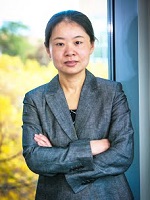

| Title: | Associate Professor |
| Dept: | Mechanical Engineering |
| Office: | FH 233 |
| Phone: | 216-687-2595 |
| Email: | w.zhang13@csuohio.edu |
| Web: | http://sites.google.com/site/weizhangumn/ |
| Address: | 2121 Euclid Ave. FH 233, Cleveland, OH 44115 |
|
| ||||||||
| Education: | ||||||||
|
Ph.D., Fluid Engineering and Thermo-physics, Xi'an Jiaotong University, 2003
B.S., Civil and Environmental Engineering, Xi'an University of Architecture and Technology, 1996 | ||||||||
| Brief Bio: | ||
| Dr. Wei Zhang earned her Ph.D. from Xi'an Jiaotong University, China (specialty: Fluid Engineering and Thermo-physics). Prior to joining CSU, Dr. Zhang has conducted research on a wide variety of topics ranging from large-scale systems such as atmospheric turbulence, tornado vortex dynamics and wind-blown sand saltation, to small-scale laminar-turbulent transition over the airfoil of micro air vehicles. Her research interests include: 1) development of non-intrusive laser and imaging based thermal/fluid measurement techniques, and 2) applications of these techniques to understand the governing mechanism of complex thermal/fluid and energy systems in nature and in industry. Dr Zhang's current research project is to understand vortex dynamics at high Reynolds number for wind hazard mitigation and turbulent wind over heterogeneous earth surface for wind energy application. | ||
| Honors and Awards: | ||
| NSF Faculty CAREER Award (2020)
Merit Recognition Award, Cleveland State University (2018, 2020) Faculty advisor for the First-place team in the International Design Competition at the AIAA Science and Technology Forum and Exposition's International Conference (AIAA SciTech 2016), 2016 | ||
| Research Interests: | ||
| * Wind energy system optimization (turbine wake aerodynamics, wake-ABL interactions in large-scale wind farms, wind-farm effects on local/global meteorology)
* Wind effects on buildings and structures in high winds (Hurricane or Tornado) * Turbulent boundary-layer flows over complex terrain (i.e., canopies, hills and mountains, water surface) * Advanced flow measurement techniques (PIV/PTV, TR-PIV, scanning PIV, PLIF, HWA, high-speed photography, pressure sensors, load cell, heat flux sensors) * Laminar-turbulence transition in micro air vehicle (MAV) applications * Particle-laden flow and sediment transport, particle-turbulence interaction | ||
| Professional Affiliations: | ||
| American Physical Society (APS DFD);
American Institute of Aeronautics and Astronautics (AIAA); American Association of Wind Engineering (AAWE); American Meteorology Society (AMS). | ||
| University Service: | ||
| Faculty advisor of the SWE CSU student chapter;
FAC ME Representative; Faculty Search Committee; College Nominating Committee; Graduate Faculty Review Committee; Engineering Student Success Executive Committee. | ||
| Professional Service: | ||
| Reviewer of journals: Experiments in Fluids, Boundary-layer Meteorology, Journal of Fluids and Structure, Environmental Research Letter, International Journal of Heat and Mass Transfer, Experimental Thermal and Fluid Science, Optics and Lasers in Engineering, Powder Technology, Journal of Visualization, International Journal of Aerospace Engineering, Journal of Wind Engineering and Industrial Aerodynamics, Geomorphology, Sedimentology, Journal of Hydrodynamics.
Reviewer of NSF proposals; Reviewer of AIAA conference submissions. | ||
| Research Grants: | ||
| 1. National Science Foundation (NSF) CMMI ECI, "CAREER: Flow Physics of Transient Rooftop Vortices at High Reynolds Number and Bio-inspired Flow Control to Mitigate Wind Hazards", $580,249 (PI, 03/2020 - 02/2025).
2. NSF IRES, "Collaborative Research: IRES Track I: US-South Korea Collaboration on Biomimicry and Bio-inspired Fluid Flows (BIO-FLOWS)", $194,998 (PI, 09/2020 - 08/2023, total $299,999, in collaboration with the teams at University of Akron, CASE and POSTECH South Korea). | ||